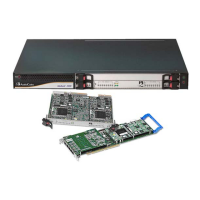SIP User's Manual 382 Document #: LTRT-68806
Mediant 2000 & TP-1610 & TP-260/UNI
9.2 Release Reason Mapping
This appendix describes the available mapping mechanisms of SIP Responses to Q.850
Release Causes and vice versa.
The existing mapping of ISDN Release Causes to SIP Responses is described in' Fixed
Mapping of ISDN Release Reason to SIP Response' on page 383 and 'Fixed Mapping of
SIP Response to ISDN Release Reason' on page 385. To override this hard-coded
mapping and flexibly map SIP Responses to ISDN Release Causes, use the ini file
(CauseMapISDN2SIP and CauseMapSIP2ISDN, as' described in ISDN and CAS
Interworking-Related' on page 311 Parameters) or the Embedded Web Server (refer to
'Release Cause Mapping' on page 132).
It is also possible to map the less commonly-used SIP Responses to a single default ISDN
Release Cause. Use the parameter DefaultCauseMapISDN2IP (described in 'ISDN and
CAS Interworking-Related Parameters' on page 311) to define a default ISDN Cause that is
always used except when the following Release Causes are received: Normal Call
Clearing (16), User Busy (17), No User Responding (18) or No Answer from User (19).
This mechanism is only available for Tel-to-IP calls.
9.2.1 Reason Header
The gateway supports the Reason header according to RFC 3326. The Reason header is
used to convey information describing the disconnection cause of a call:
Sending Reason header: If a call is disconnected from the Tel side (ISDN), the
Reason header is set to the received Q.850 cause in the appropriate message (BYE /
CANCEL / final failure response) and sent to the SIP side. If the call is disconnected
because of a SIP reason, the Reason header is set to the appropriate SIP response.
Receiving Reason header: If a call is disconnected from the IP side and the SIP
message includes the Reason header, it is sent to the Tel side according to the
following logic:
• If the Reason header includes a Q.850 cause, it is sent as is.
• If the Reason header includes a SIP response:
♦ If the message is a final response, the response status code is translated to
Q.850 format and passed to ISDN.
♦ If the message isn’t a final response, it is translated to a Q.850 cause.
• When the Reason header is received twice (i.e., SIP Reason and Q.850), the
Q.850 takes precedence over the SIP reason and is sent to the Tel side.

